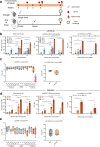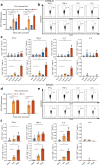A core-shell structured COVID-19 mRNA vaccine with favorable biodistribution pattern and promising immunity
- PMID: 34059617
- PMCID: PMC8165147
- DOI: 10.1038/s41392-021-00634-z
A core-shell structured COVID-19 mRNA vaccine with favorable biodistribution pattern and promising immunity
Abstract
Although inoculation of COVID-19 vaccines has rolled out globally, there is still a critical need for safe and effective vaccines to ensure fair and equitable supply for all countries. Here, we report on the development of a highly efficacious mRNA vaccine, SW0123 that is composed of sequence-modified mRNA encoding the full-length SARS-CoV-2 Spike protein packaged in core-shell structured lipopolyplex (LPP) nanoparticles. SW0123 is easy to produce using a large-scale microfluidics-based apparatus. The unique core-shell structured nanoparticle facilitates vaccine uptake and demonstrates a high colloidal stability, and a desirable biodistribution pattern with low liver targeting effect upon intramuscular administration. Extensive evaluations in mice and nonhuman primates revealed strong immunogenicity of SW0123, represented by induction of Th1-polarized T cell responses and high levels of antibodies that were capable of neutralizing not only the wild-type SARS-CoV-2, but also a panel of variants including D614G and N501Y variants. In addition, SW0123 conferred effective protection in both mice and non-human primates upon SARS-CoV-2 challenge. Taken together, SW0123 is a promising vaccine candidate that holds prospects for further evaluation in humans.
Conflict of interest statement
Stemirna Therapeutics filed patents on patent application entitled “A prophylactic or therapeutical 2019-nCoV mRNA vaccine”. All other authors declare no conflict of interest.
Figures






Similar articles
-
A single dose of self-transcribing and replicating RNA-based SARS-CoV-2 vaccine produces protective adaptive immunity in mice.Mol Ther. 2021 Jun 2;29(6):1970-1983. doi: 10.1016/j.ymthe.2021.04.001. Epub 2021 Apr 5. Mol Ther. 2021. PMID: 33823303 Free PMC article.
-
Chimeric spike mRNA vaccines protect against Sarbecovirus challenge in mice.Science. 2021 Aug 27;373(6558):991-998. doi: 10.1126/science.abi4506. Epub 2021 Jun 22. Science. 2021. PMID: 34214046 Free PMC article.
-
Measuring cellular and humoral immunogenicity of a SARS-CoV-2 mRNA vaccine (BNT126b2) in patients on maintenance haemodialysis.EBioMedicine. 2021 Sep;71:103567. doi: 10.1016/j.ebiom.2021.103567. Epub 2021 Aug 26. EBioMedicine. 2021. PMID: 34454401 Free PMC article. No abstract available.
-
Key Considerations for the Development of Safe and Effective SARS-CoV-2 Subunit Vaccine: A Peptide-Based Vaccine Alternative.Adv Sci (Weinh). 2021 Aug;8(16):e2100985. doi: 10.1002/advs.202100985. Epub 2021 Jun 27. Adv Sci (Weinh). 2021. PMID: 34176237 Free PMC article. Review.
-
Immunogenicity of clinically relevant SARS-CoV-2 vaccines in nonhuman primates and humans.Sci Adv. 2021 Mar 19;7(12):eabe8065. doi: 10.1126/sciadv.abe8065. Print 2021 Mar. Sci Adv. 2021. PMID: 33608249 Free PMC article. Review.
Cited by
-
Recent Advancements in mRNA Vaccines: From Target Selection to Delivery Systems.Vaccines (Basel). 2024 Aug 1;12(8):873. doi: 10.3390/vaccines12080873. Vaccines (Basel). 2024. PMID: 39203999 Free PMC article. Review.
-
Novel Ionizable Lipid Nanoparticles for SARS-CoV-2 Omicron mRNA Delivery.Adv Healthc Mater. 2023 May;12(13):e2202590. doi: 10.1002/adhm.202202590. Epub 2023 Feb 17. Adv Healthc Mater. 2023. PMID: 36716702 Free PMC article.
-
Antigen Delivery Systems: Past, Present, and Future.Biomol Ther (Seoul). 2023 Jul 1;31(4):370-387. doi: 10.4062/biomolther.2023.006. Epub 2023 Apr 19. Biomol Ther (Seoul). 2023. PMID: 37072288 Free PMC article. Review.
-
MHCI trafficking signal-based mRNA vaccines strengthening immune protection against RNA viruses.Bioeng Transl Med. 2024 Aug 15;10(1):e10709. doi: 10.1002/btm2.10709. eCollection 2025 Jan. Bioeng Transl Med. 2024. PMID: 39801759 Free PMC article.
-
Immunological evaluation of an mRNA vaccine booster in individuals fully immunized with an inactivated SARS-CoV-2 vaccine.Clin Transl Med. 2022 Jun;12(6):e875. doi: 10.1002/ctm2.875. Clin Transl Med. 2022. PMID: 35678117 Free PMC article. No abstract available.
References
Publication types
MeSH terms
Substances
LinkOut - more resources
Full Text Sources
Other Literature Sources
Medical
Miscellaneous

